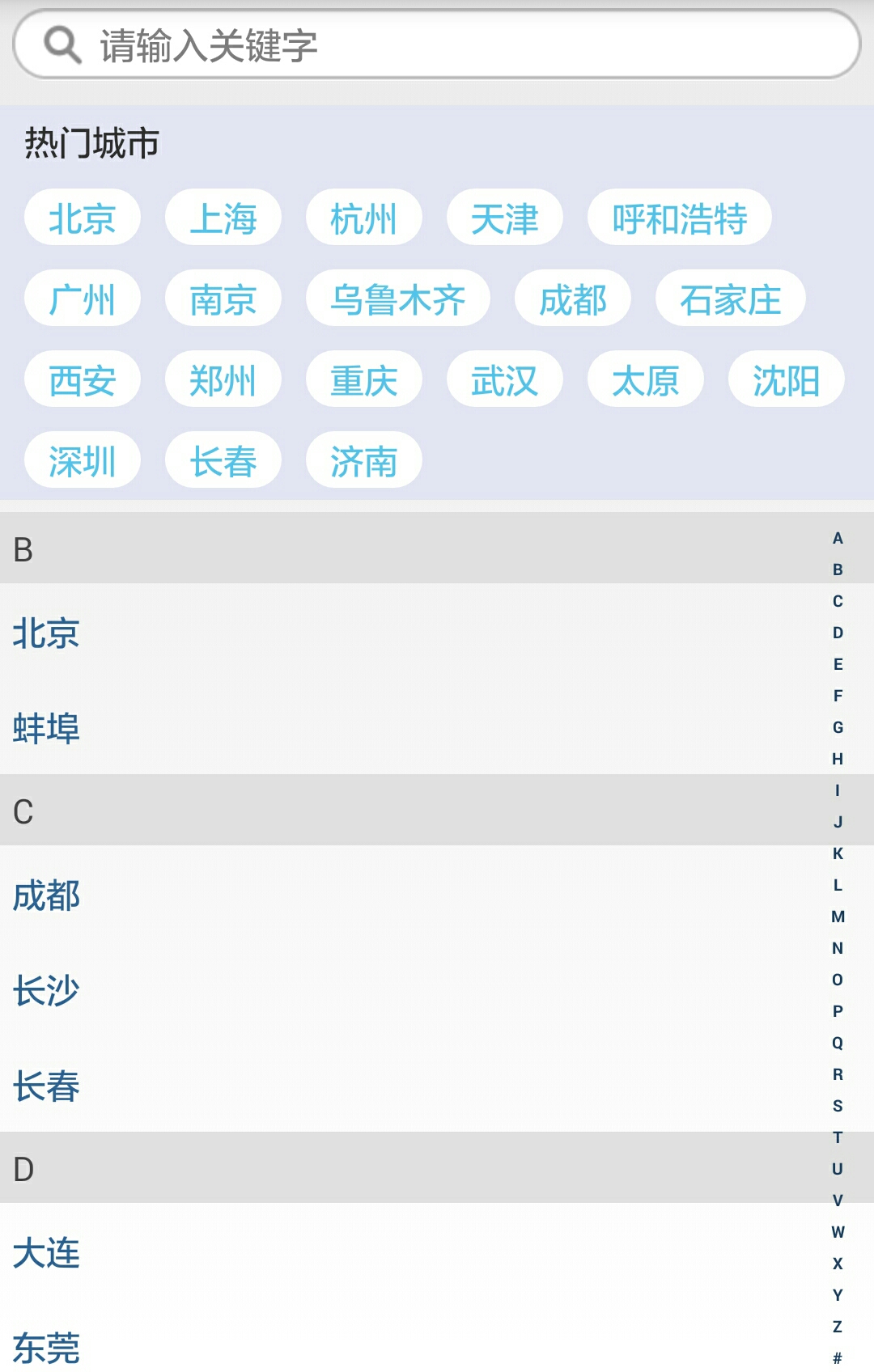流布局在实际项目中应用非常广泛,它的子控件摆放方式为:依次从左至右摆放子控件,如果这一行中剩余的空间不能够再摆放下一个控件,则进行换行。每一行的行高为该行中高度最高的子控件高度。
下图是一个Demo应用中某个页面的截图,其中热门城市部分是流布局的一个实现样例。
流布局的实现通过自定义ViewGroup完成,在自定义ViewGroup中,最重要的是覆写其中的onMeasure()和onLayout()两个方法。前者决定自定义ViewGroup的尺寸,后者决定了ViewGroup中每个子view的摆放。
如果能够在自定义布局中设置每个子View的margin值,那将极大扩展我们使用的灵活性,因此为了做到这一点,首先需要重写generateLayoutParams方法,并在其中返回一个MarginLayoutParams。
@Override
public LayoutParams generateLayoutParams(AttributeSet attrs)
{
return new MarginLayoutParams(getContext(), attrs);
}
接下来实现onMeasure方法,在该方法中,我们的最终目标是得到整个ViewGroup的宽高。因此我们需要遍历所有的子控件,并根据它们的测量宽高来决定每行的宽高。
这里需要注意以下几点:
1、宽和高不能超过父控件的限制,因此换行的条件取决于父控件分给它们的最大宽度。
2、每个子控件的测量宽度,不包括它的左右margin值,测量高度不包括它的上下margin值,父控件分给它们的宽高包含了父控件的padding值。
3、Visibility为GONE的不需要显示,同样也不需要进行测量
4、整个布局的最终宽高要根据测量模式决定。
根据上面分析,onMeasure的代码如下:
@Override
protected void onMeasure(int widthMeasureSpec, int heightMeasureSpec)
{
int widthMode = MeasureSpec.getMode(widthMeasureSpec);
int widthSize = MeasureSpec.getSize(widthMeasureSpec);
int heightMode = MeasureSpec.getMode(heightMeasureSpec);
int heightSize = MeasureSpec.getSize(heightMeasureSpec);
//实际高度时使用
int height = 0;
int width = 0;
//记录每一行的宽度和高度
int lineWidth = 0;
int lineHeight = 0;
//内部元素的个数
int count = getChildCount();
for (int i = 0; i < count; i++)
{
//获得子view
View child = getChildAt(i);
if (View.GONE == child.getVisibility()) //不需要显示
{
continue;
}
//测量子view的宽和高
measureChild(child, widthMeasureSpec, heightMeasureSpec);
//得到子view的param
MarginLayoutParams mlp = (MarginLayoutParams) child.getLayoutParams();
//子view占据的宽度和高度
int childWidth = child.getMeasuredWidth() + mlp.leftMargin + mlp.rightMargin;
int childHeight = child.getMeasuredHeight() + mlp.topMargin + mlp.bottomMargin;
//当前行宽加上子view宽度 大于 容器行宽 减 内边距
if (lineWidth + childWidth > widthSize - getPaddingLeft() - getPaddingRight())
{
//换行,布局行宽为 当前行宽 与 之前记录的最大行宽 中 取较大值
width = Math.max(width, lineWidth);
//重置 当前行宽
lineWidth = childWidth;
//叠加布局行高
height += lineHeight;
//重置行高
lineHeight = childHeight;
}
else //不换行
{
lineWidth += childWidth;
lineHeight = Math.max(lineHeight, childHeight);
}
//到达最后一个控件,合计控件宽和高,此时得到wrap_content时的宽度和高度
if (i == count - 1)
{
width = Math.max(lineWidth, width);
height += lineHeight;
}
}
//根据测量模式决定最终的宽和高
int finalwidth = 0, finalheight = 0;
switch (widthMode)
{
case MeasureSpec.EXACTLY:
finalwidth = widthSize;
break;
case MeasureSpec.AT_MOST:
finalwidth = (width + getPaddingLeft() + getPaddingRight() < widthSize ? width + getPaddingLeft() + getPaddingRight() : widthSize);
break;
case MeasureSpec.UNSPECIFIED:
finalwidth = width + getPaddingLeft() + getPaddingRight();
break;
default:
finalwidth = width + getPaddingLeft() + getPaddingRight();
}
switch (heightMode)
{
case MeasureSpec.EXACTLY:
finalheight = heightSize;
break;
case MeasureSpec.AT_MOST:
finalheight = (height + getPaddingTop() + getPaddingBottom() < heightSize ? height + getPaddingTop() + getPaddingBottom() : heightSize);
break;
case MeasureSpec.UNSPECIFIED:
finalheight = height + getPaddingTop() + getPaddingBottom();
break;
default:
finalheight = height + getPaddingTop() + getPaddingBottom();
}
//设置宽高值
setMeasuredDimension(finalwidth, finalheight);
} 最后实现onLayout方法,在这个方法中,我们要决定每个子view摆放的位置。在摆放子view时,我们需要知道子view的宽高以及左上角的位置,其中宽和高都比较容易得到,左上角的位置需要我们在摆放子控件的过程中不断更新。
我这里采用的方法如下:首先遍历所有的子控件,在这个过程中,决定每一行分别要放哪些控件,并将他们存起来。此外,由于行高要在换行时才能决定,因此需要在换行时存下这一行的行高。在完成这些之后,根据刚刚记录下的信息,填充每一行的控件。这里直接把代码贴上来。
@Override
protected void onLayout(boolean changed, int l, int t, int r, int b)
{
mAllViews.clear();
mLineHeight.clear();
int width = getWidth(); //因为已经测量完成,所以可以直接获取
int lineWidth = 0;
int lineHeight = 0;
//每一行的View
List<View> lineViews = new ArrayList<View>();
int count = getChildCount();
for (int i = 0; i < count; i++)
{
View child = getChildAt(i);
if (View.GONE == child.getVisibility()) //不需要显示
{
continue;
}
MarginLayoutParams mlp = (MarginLayoutParams) child.getLayoutParams();
int childWidth = child.getMeasuredWidth();
int childHeight = child.getMeasuredHeight();
//需要换行
if (childWidth + mlp.leftMargin + mlp.rightMargin + lineWidth > width - getPaddingLeft() - getPaddingRight())
{
//记录行高
mLineHeight.add(lineHeight);
//记录当前行views
mAllViews.add(lineViews);
//重置行宽和行高
lineWidth = 0;
lineHeight = mlp.topMargin + childHeight + mlp.bottomMargin;
//重置集合,注意这里不能clear,因为已经加到队列里了
lineViews = new ArrayList<View>();
}
//这里不能加else块哦
lineHeight = Math.max(lineHeight, mlp.topMargin + childHeight + mlp.bottomMargin);
lineWidth += childWidth + mlp.leftMargin + mlp.rightMargin;
lineViews.add(child);
}
//额外处理最后一行
mLineHeight.add(lineHeight);
mAllViews.add(lineViews);
//设置子view的位置
int left = getPaddingLeft(); //view的开始位置
int top = getPaddingTop(); //view的顶部位置
//行数
int lineCount = mAllViews.size();
for (int i = 0; i < lineCount; i++)
{
//当前行的所有的View
lineViews = mAllViews.get(i);
//当前行Height
lineHeight = mLineHeight.get(i);
//当前行view的个数
int lineViewCount = lineViews.size();
for (int j = 0; j < lineViewCount; j++)
{
View child = lineViews.get(j);
MarginLayoutParams mlp = (MarginLayoutParams) child.getLayoutParams();
//控件的四个顶点
int leftchild = left + mlp.leftMargin;
int topchild = top + mlp.topMargin;
int rightchild = leftchild + child.getMeasuredWidth();
int bottomchild = topchild + child.getMeasuredHeight();
//为子View进行布局
child.layout(leftchild, topchild, rightchild, bottomchild);
left += mlp.leftMargin + child.getMeasuredWidth() + mlp.rightMargin;
//每一行内的高度起始值是一样的,因此不用改变
}
//行间操作
left = getPaddingLeft();
top += lineHeight;
}
}
这个过程相对来说比较冗长,不过理解起来并没有什么困难,需要注意的是一些边界条件,比如:最后一行和每行最后一个元素的处理,换行时更新控件的左上角坐标等等。
按照以往习惯,附上源代码链接:流布局源代码






















 759
759











 被折叠的 条评论
为什么被折叠?
被折叠的 条评论
为什么被折叠?








